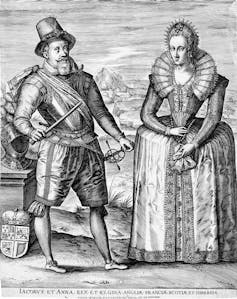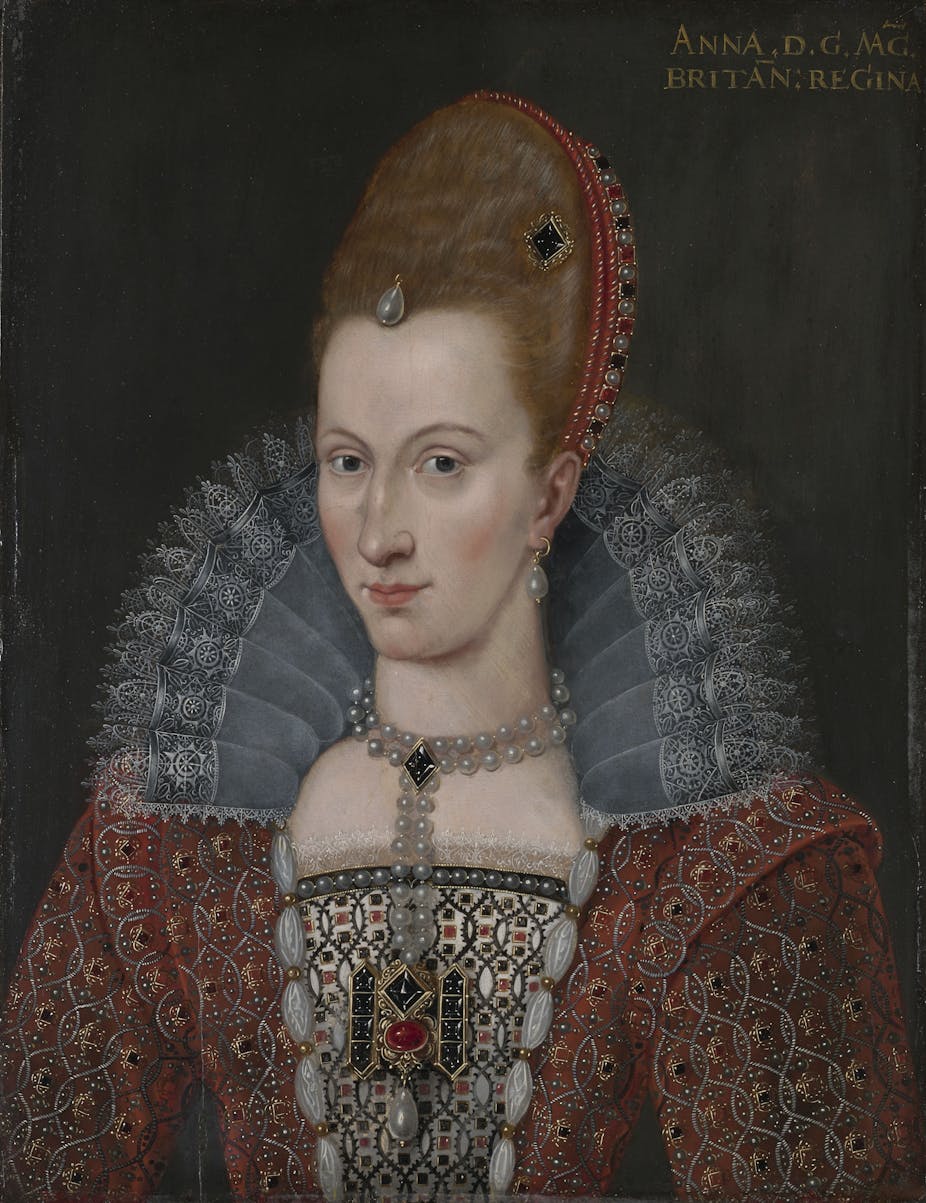England in the 17th century was a thoroughly male affair. Men dominated politics, law, religion and the military, and women were relegated to the domestic sphere. But, then again, the previous century had seen England actually ruled by two women in succession: Queens Mary I and Elizabeth I. Was there nothing between these two extremes?
We might be too quick to think there wasn’t, for gender relations – and women’s ability to wrestle political gain from cultural and social means – were rather more subtle, murky, and nuanced than these two poles suggest. After the death of the legendary Elizabeth I in 1603, her cousin, James VI of Scotland, succeeded to the throne as James I and England was back in the hands of male rule. But James brought with him a young wife – Anne of Denmark – who makes an interesting case for female agency.
Anne owed her position as queen to her marriage (although she was of royal Danish blood); she owed most of her power to having “the king’s ear”; she did not hold any formal office, and she was firmly below James in the hierarchy. But thanks to the nature of her relationship with James, his obsession with hunting, the structure of the court, and Anne’s alliance with strategic male courtiers, she enjoyed some independence and influence.
First, early Stuart England was home to two centres of power beyond that of the king: those of the queen and the prince. These ancillary courts supported household favourites, policies, aesthetics, and cultural forms that could be completely separate from James’s court. This difference did not amount to rebellion, or rejection, but fuelled a climate of debate and diversity, and ensured factional balance.
In several areas, Anne actively diverged from James: in her patronage of artists and designers, in the style of portraiture, in her preferred clients for court posts, in factional support, and through her passion for building and garden design.
Second, geographic distance was a defining feature of the royal relationship. Passionate about hunting, and aware of the political benefits of mobility, James absented himself from London for between six and nine months a year. His ability to do so, without the kingdom falling into disarray, was ensured by the proficiency of his privy councillors, most notably Robert Cecil – and his wife, Anne.
A conduit to the king
Anne spent most of her time in London, where she served as an intermediary between James and the council, passing on the king’s “dispatch” and hosting weekly meetings “in such places as our dearest wife shall Keepe her Courte”.

Frequently tasked as the monarchical representative in London, Anne was readily accessible to dignitaries and elites who valued her as a conduit to, and a spokesperson for, the king. When rumours were rife about England’s future marriage alliance through Anne and James’ eldest son, and heir to the throne, Prince Henry, several ambassadors pegged Anne as the most reliable source of information, and actively sought her opinion.
Her sway with the king was also noted by Spain, who considered her key to the success of their marriage bid, and sought her favour through one of the most popular means: gifts. When an ambassador was sent to London for four days – to congratulate James for surviving the Gunpowder Plot – his other political duty was to get an audience with Anne, and give her clothes and jewels.
The level of influence Anne actually held with James is another matter, but perceptions were almost as important as the real thing.
Playing the patriarchy
But even though the court was polycentric, it was also patriarchal. Anne was barred from holding office, but her proximity to the king meant that her actions and views carried political weight.
She was also careful to align herself with men who shared her opinion, and could speak or act on her behalf when necessary. Between 1610 and 1612, she worked with her eldest son, Prince Henry, to curb the power of James’s favourite, Robert Carr.
On one occasion, Carr was made Chief Clerk of the Court of Common Pleas, but was forced to share the office with John Harington – a close companion of Henry, and brother of Anne’s principal lady-in-waiting. When there was competition for the secretariat, Carr quickly chose to support Anne and Henry’s candidate, as he was “not willing … to oppose himself, or stand in the breach against such assailants”.
Later, Anne played a key role in Carr’s displacement, working with the faction headed by the Earls of Pembroke and Southampton to bring in George Villiers as the new favourite. Against Carr’s vocal protestations, Anne pushed James to make Villiers a Gentleman of the Bedchamber, where he would be guaranteed access to the king (and therefore power). James heeded his wife’s recommendation, thereby starting the legendary rise of Villiers.
As the chief favourite of King James, and then King Charles I, Villiers ultimately became Duke of Buckingham, Knight of the Garter, privy councillor, and Lord Admiral – arguably, the most powerful man at court. His relationship with Anne was always good, and it was well known that “since the fall of her enemy [Carr], Mr Villiers has risen, supported by her and dependent on her”.
The formal structure of 17th-century England was highly unfavourable for women. Anne of Denmark, however, proved that political power could still be achieved, however unfavourable the odds.

